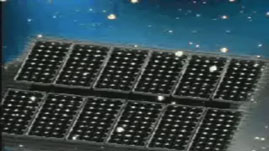Teachers' Domain - Digital Media for the Classroom and Professional Development
User: Preview

Source: U.S. Department of Energy
This animation shows how photovoltaic panels and their solar cells capture sunlight's energy and create electricity. Sunlight is made up of tiny energy packets called photons. Every minute enough of this energy reaches the earth to meet a year's worth of the earth's energy needs.
Photovoltaic panels consist of many solar cells, made of materials like silicon, a commonly available element. Solar cells are designed to free electrons from absorbed photons with a positive and a negative layer that create an electric field, just like in a battery. Photovoltaic panels can be designed to meet specific energy needs.
The word photovoltaic is a combination of the word photo meaning light and the word voltaic meaning the production of energy. Photovoltaic panels are panels that generate electricity from light.
To understand photovoltaics, it's necessary to know something electricity and three important concepts: Voltage, Current, and Power.
Voltage, measured in volts, is a measure of the electrical force between two points. Voltage is the cost in energy required to move a unit of positive charge from a more negative point (low potential) to the more positive point (higher potential).
Current, measured in amperes or amps, is a measure of the number of electrons flowing through a wire in a particular time. It is analogous to gallons of water per second flowing in a hose.
The third concept is that of power. Power is simply voltage times current. It is also the amount of energy that is delivered in a unit of time.
Photovoltaic panels are made up of many solar cells. The animation above from the U.S. Department of Energy illustrates how solar cells produce electricity on a microscale.
To place a building with photovoltaic panels efficiently in a location, an architect and/or contractor need to consider two factors: the pitch or tilt of a roof with photovoltaic panels as well as the direction it faces. Try to optimize the electrical output of a photovoltaic system by manipulating an interactive animation How PV Works at this link: http://www.greenspec.co.uk/html/energy/pvcells.html
The advantage of photovoltaic panels is that sunlight, the source of energy, is free, renewable and available anywhere on earth. Photovoltaic energy can be used either locally or distributed to far away places. Systems have no moving parts, are modular, can be expanded and transported, and when designed well and maintained, will last 20 to 30 years.
However, like wind power electric systems, photovoltaic energy systems require a substantial outlay of cash initially, an investment that can be recouped over time. And like wind power electric systems require enough wind, photo voltaic systems require enough sunlight to make the conversion to electricity economically viable. In other words, placing a photovoltaic system in the shade is counter-productive.
Systems can be connected to the electrical grid, provide grid support, be completely independent of the grid or combine with other electrical systems. [1]
[1] The web page Photo Voltaic (PV) Cells was produced by Green Spec, as guide for contractors who want to build "green" in the United Kingdom, and is the source of general information about advantages, disadvantages and types of photovoltaic electric systems. The interactive animation How PV Works was produced by Solar Century, a company that produces solar electric roof tiles. Retrieved August 21, 2008 from http://www.greenspec.co.uk/html/energy/pvcells.html.
 Loading Standards
Loading Standards